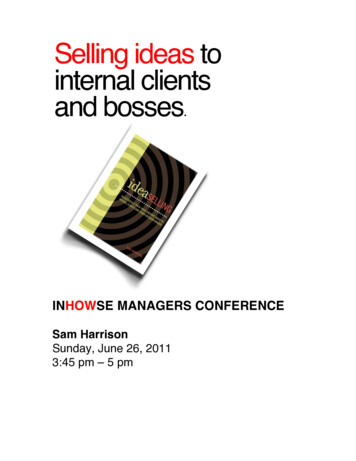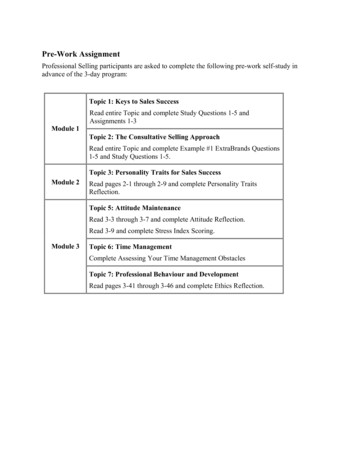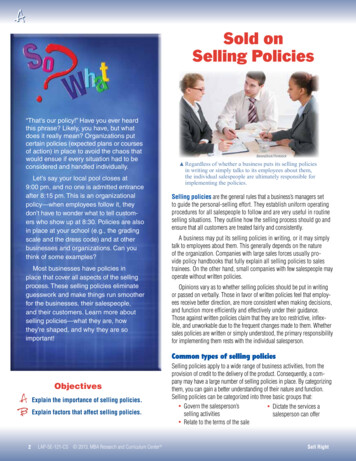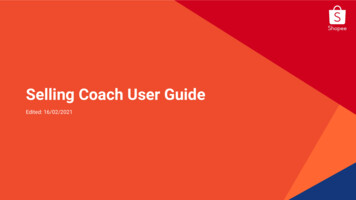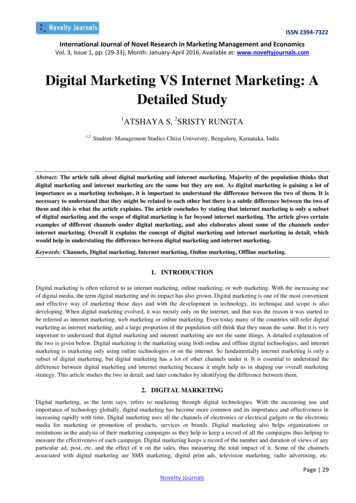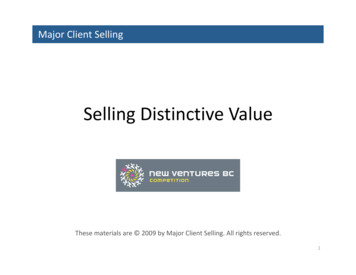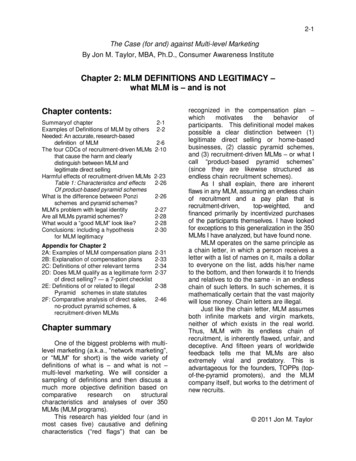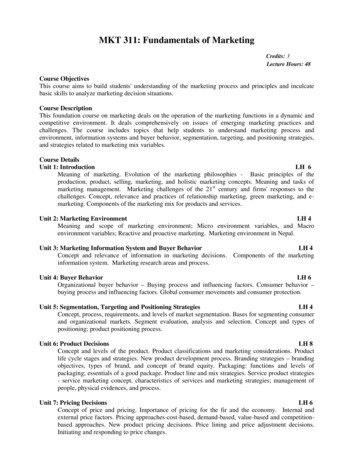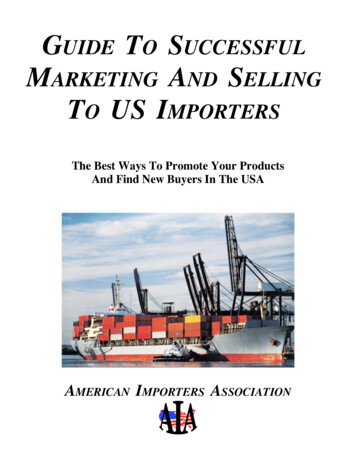
Transcription
GUIDE TO SUCCESSFULMARKETING AND SELLINGTO US IMPORTERSThe Best Ways To Promote Your ProductsAnd Find New Buyers In The USAAMERICAN IMPORTERS ASSOCIATION
Important Disclaimer:This guide is designed to provide general information that will help exporters around theworld contact and do business with importers in the USA. It is not intended to be acomprehensive guide.It is sold with the understanding that this association is not a legal office, customsbroker, or agent of the US government. If expert assistance in exporting to the USA isrequired, the services of a competent professional should be sought.We have tried to insure the accuracy of the information in this guide. However, intoday's fast paced business world data, laws, and other information change very rapidly.This association takes no responsibility for inaccurate or incomplete information. Nowarranty as to the accuracy is given.The information in this guide is provided to help with the understanding of andcompliance with importing laws and regulations in the USA. The information in thisguide is for general information only. Exporters wishing to do business with USimporters may also want to get guidance from licensed customs brokers, attorneys orconsultants.Guide To Successful Marketing And Selling To US Importers. Copyright 2008 bythe American Importers Association. Written and printed in the United States ofAmerica. All rights reserved. No part of this guide may be reproduced in any formwithout the written permission from the AIA.AMERICAN IMPORTERS ASSOCIATION214 7th Street, N.Safety Harbor, FL 34695www.americanimporters.org information@americanimporters.orgTel: (727) 204-8500 Fax: (727) 726-01192
Table Of Contents1. The Steps in Selling To US Importers42. Best Ways to Market and Sell to US Importers93. How NOT To Market And Sell To US Importers124. Reasons Exporters Are Not Successful In The US Market175. What Are The Main Opportunities For Exporting To The USA196. Being An Agent for US Importers227. Making Sure You Get Paid258. How To Know If A US Importer Is Reliable289. Sample Sales Letters3010. Using E-Mail to Market And Sell3611. Designing Your Web Site To Get The Most Sales Inquiries4112. Selling at Trade Fairs4613. Using B2B Portal Web Sites4914. Helping Your Buyer Get The Shipment Through Customs523
Chapter OneThe Steps in Selling To US ImportersSelling to US importers can be very large and complex and it can be small and simple.The general concepts, however, remain the same. The US is the world’s largestimporting country. But doing business with US importers is highly competitive. Exportersfrom almost every country in the world would like to export to the US. US importers areable to be very selective and most often dictate the terms of business transactions.Being successful selling to US importers requires understanding the import process.This section is not a discussion of how to market to US importers. This is done in thechapter Best Ways To Market And Sell To US Importers. This is a discussion of theimport process through the eyes of the US importer. Understanding it can be the key tosuccess. Not understanding it can be the key to failure.The biggest mistake an exporter can make is if he/she tries to sell to US importers in thesame way they would sell to buyers in their own country or in Europe, for example. TheUS has its own set of rules, business customs – and laws.Finding Buyers in the USWhen trying to establish a successful and long term exporting business you shouldchoose your buyers overseas even more carefully than you choose your buyers in yourown country. Doing business with someone who is very far away, with a different set ofcustoms and laws, and who may speak a different language is much more difficult thandoing business with local buyers.There are several places that an exporter can go to find prospective buyers. Trade fairs,B2B web sites, and contacting that country’s embassy are just a few. Our ownDatabase List of US Importers is a great place to start. It lists the company names,contact information, and products imported of approximately 13,000 importers in theUS.A good business practice for exporters is not to limit themselves to just one – or eventwo- buyers. If the exporter loses that buyer then business to the US virtually stops untila new buyer can be found. Try to have as many customers as you can realisticallysupply. If one buyer stops buying you can reply on the others until a new replacementbuyer is found. Be careful, however, not to spread yourself too thin. Having too manycustomers could mean giving them poor service and delivering their goods late. Thesetwo mistakes are sure to cost you customers.Another point to remember is that many of the US importers in a certain sector knoweach other. They meet at trade fairs, sector specific conventions and meetings, andthrough word of mouth. If you as the exporter give a US importer poor service, poorquality, late delivery, or behave in a way that an exporter should not behave, it WILL getaround to the other importers in that sector. Some sectors keep “black list” of exporters4
that have behaved unprofessionally. As an exporter you want to make sure that youalways give good service, provide a good quality product, and deliver on time. If youdon’t, not only will you lose that customer but there is a real potential you will lose manyothers by being black listed.Negotiating the TermsAfter you have found a US importer that is willing to buy from you, you must establishthe terms and conditions on which you will sell your products. Three of the biggestmistakes that an exporter can make are:1) Accepting an offer that is beyond that exporter’s capacity. Greed and wishfulthinking sometimes lead to an exporter accepting an order that he/she knows istoo big.2) Agreeing to ship the goods in an unrealistically short period of time. The buyer iscounting on you to deliver the good on the date that you promised. Not doing soputs the buyer in a very bad situation.3) Agreeing to give the buyer credit without first doing a credit and reference checkon the buyer. The vast majority of US importers are honest. But there are somewho prey on exporters. They place orders, ask for credit, and have no intention ofpaying. For more information on this topic see the chapters on Making SureYou Get Paid and How To Know If A US Importer Is Reliable.Negotiating is a give and take process that must benefit both parties in order for thebusiness relations to be long term and profitable.Writing the Sales ContractThis includes the product/s to be sold, the price, payment terms, and any other detailsof the sale. This should also include what to do in case of a dispute or conflict. You mustdecide to use your country’s laws or the buyer’s country’s law in case of dispute. Youmay also choose to have the dispute go to arbitration. The sales contract is one of themost important steps in doing business with US importers. You must legally protectyourself.Usually the agreement is paragraphed and headed by numbers. A sample salescontract might look like this:XYZ CorporationBASE AGREEMENT1.0 ORDERING1.1 Customer and its wholly owned Subsidiaries may order Products and relatedservices by sending XYZ Corporation a written purchase order. XYZ Corporation willconfirm receipt of orders. 2.0 CUSTOMER'S RESPONSIBILITIESCustomer represents and warrants that:2.1 Products will be: (a) integrated or incorporated into systems sold under Customer'slogo or trade name unless otherwise specified by XYZ Corporation in writing. 3.0 SHIPMENT, TITLE, RISK OF LOSSXYZ Corporation will provide an estimated shipment date in the order confirmation.5
Customer is responsible for all freight and duty charges for all Products acquired byCustomer under this PSA from XYZ Corporation 's shipping location. 4.0 PAYMENT TERMSXYZ Corporation shall invoice Customer after the Products have been shipped.Customer shall pay the full amount of the invoice within thirty (30) days of the invoicedate, 5.0 CANCELLATION AND RESCHEDULINGXYZ Corporation may charge a fee for cancellation or rescheduling of the Products asset forth in the Product Attachment(s). 6.0 CHANGES6.1 In the event that XYZ Corporation 's ability to supply Product becomes constrained,XYZ Corporation may, as XYZ Corporation deems reasonable, reduce quantities ordelay shipments to Customer.Packing and PackagingIt is the importer’s responsibility to notify you of the packing and labeling requirementsfor the products that he/she has ordered. The products must be labeled in accordancewith US Customs rules and regulations. This is especially important for certain items likefood, chemicals, and clothing. The products must be packed in a way that they willarrive at the final destination in good shape. The goods will most probably be loadedonto several vehicles before arriving at the importer’s warehouse.Information on how to pack goods for the purpose of transporting them may be obtainedfrom shipping manuals, carriers, forwarding agents, and other sources. It is importantthat goods being exported be packed in a way that will permit US Customs officers toexamine, weigh, measure, and release them promptly.Orderly packing and proper invoicing go hand in hand. You will speed up the clearanceof your goods through US Customs if you: Invoice your goods in a systematic manner,Show the exact quantity of each item of goods in each box, bale, case, orother package,Put marks and numbers on each package,Show those marks or numbers on your invoice opposite the itemization ofgoods contained in the package that bears those marks and numbers.It is easier for US Customs to examine the shipment when packages contain goods ofone kind only, or when the goods are imported in packages the contents and values ofwhich are uniform. If the contents and values differ from package to package, thepossibility of delay and confusion is increased. Sometimes, because of the kinds ofgoods or because of the unsystematic manner in which they are packed, the entireshipment must be examined.Packing a combination of different types of goods makes it difficult for US Customsofficers to determine the quantity of each type of product in a shipment. Such packing6
can also lead to a variety of other complications in the entry process. There should beno problem, however, from the orderly packing of several different kinds of properlyinvoiced goods in a single package. It is packing different goods in different containersthat cause difficulty.Labeling is important for all sectors. But it is especially important for the clothing, textileand fabric sectors. Textile and apparel exporters but ensure that the documentationcovering the imported merchandise, its packaging and its labeling, accurately identifythe importation’s country of origin.Shipping the GoodsThe importer will generally decide on the shipping arrangements. The terms of theshipping must be clearly laid out in the sales agreement. The importer must select thebest carrier, price, routing, container, and scheduling for the shipment. Few USimporters will rely on the exporter to decide this.Obtaining InsuranceEither the importer or the exporter must insure the shipment. Be sure to insure the fullvalue of the goods. This includes packaging, shipping, storage, and any duties andtaxes that may be due. This can be done shipment by shipment whereby you insureeach individual shipment. Or this can be done on a term-policy basis with a broker orwith an insurance company.There are usually three kinds of cargo insurance.1) All Risk: This kind covers your shipment from your door to theirs. It also coverspartial shipments and total loss or damage.2) With Average: This kind covers your cargo for partial and total loss or destructionon the main carrier only. That means your shipment is covered while it is on theship. It is not covered while on the truck to the ship or from the ship to theimporter. Not is it covered on the pier while it is waiting to be loaded.3) Free of Particular Average: This kind covers your shipment only on the maincarrier and only if there is total loss, damage, or destruction.You can choose to buy insurance on a shipment by shipment basis. Or you can get ablanket policy on a yearly basis. For more information you should contact your freightforwarder or your insurance agent. The greatest amount of marine insurance is writtenunder an “open policy”. These are insurance agreements that remain active until theyare cancelled. Under this system individual shipments can be reported and declaredwithout the need to apply for a whole new policy.The exporter should know that the “all risk” kind of cargo insurance does not include allrisks. It covers only physical loss or damage from external causes. It does not includedamage due to war, strikes, or riots.Clearing US CustomsThis topic is covered in much more detail in the chapter Helping Your Buyer Get TheShipment Through US Customs. In brief, you the exporter are 1) responsible to packthe shipment in such a way as to make it easy for US Customs to examine theshipment. You are also 2) responsible for making sure that all documents are correctlyfilled out. Obeying these two requirements will help to insure that you keep that7
customer for many orders in future. Failing to obey these requirements will almostcertainly mean that the importer will be looking for another supplier for the next order.In almost all cases the importer is responsible for getting the goods through USCustoms and into the country. Most importers hire a customs broker to deal withCustoms entry and clearance procedures. However, in order to get the goods throughCustoms the exporter must have followed the importer’s instructions as outlines in thesale contract (labeling etc). In addition, the exporter must supply proper documentation.Without this documentation the importer cannot get the goods out of Customs. In manycases the receiving of the specified and properly filled out documents is a requirementfor payment.8
Chapter TwoBest Ways to Market and Sell to US ImportersThe USA is the world’s largest importing country. US importers and buying agents arealways looking for new products to sell. US consumers are hungry for a wide variety ofproducts.However, marketing and selling to US importers can be very difficult. There iscompetition from exporters in almost every country of the world. Being successful infinding US importers to buy your product requires patience and knowledge of how thesystem works. With so many exporters trying to sell them products, US importers canbe very selective. It is extremely important that you the exporter understand yourproducts potential in the US market, the best ways to market and sell it, and how to getalong with the importer.There are a variety of ways to market your product to US importers. The best way foryou depends on your product, the market you are trying to reach, what country you arein, and your budget. Building a strong and profitable customer base in the US takestime, work, and money. There is no easy, fast, or cheap way to do it.Use Direct MarketingDirect marketing remains one of the most effective ways of reaching and convincingimporters to buy your product or service. Yes it is more expensive than some of theother ways. And yes it does take more time to get results. But the results that you willget are MUCH greater than with any other technique. Direct marketing means sending asales letter (and possibly a brochure) by mail to importers who you know might beinterested in your product.The first thing you need is a list of prospective buyers. A list of approximately 13,000 USimporters in a variety of different sectors can be found on the CD List of US Importersand Buying Agents.Sales letters are more effective than any other form of marketing, except maybe tradefairs. Telephoning is hard and can reach only one person at a time – if you reach themat all. Sending a fax without the person’s permission is illegal and hated. Sending SPAMe-mail doesn’t work. What US importers want is a sales letter that they read at a timethat is convenient to them. They read the first line, or paragraph, to see if they areinterested in your product. Then they skip down to the last paragraph looking for theweb site address. If they are still interested they turn to their computer and go to yourweb site. It is here that they get the information about your products, make a decision ifthey are interested or not, and contact you for more details or a price quote.Exporters who understand this first paragraph to last paragraph for web site address tocomputer to your web site technique that US importers use should do well. Exporters9
that continue to write long and wordy letters, do not have their web site address in thelast paragraph, or use some other form of marketing are not going to do well.It is important to send your sales letters out over a period of time. For example, if youfind 500 companies on our database list that you want to send a sales to letter to, do notsend all the letters at the same time. It may be that you cannot afford such a cost all atonce. And if you have a product that US importers are really interested in at a price theyare willing to pay it might be that you get this huge spike in orders all at once and arenot able to produce that much. Spread the sending of your sales letters over time, say,six months or so. This way it is easier on your budget, you are sure that you can handlethe amount of orders coming in, and you will have orders coming in over a longer periodof time.Keep Your Sales Letters Simple and ShortThe second thing you need is a really good sales / marketing letter. More detailedinformation is in the section Sample Sales Letters. Your sales letter should have fourparagraphs, not more and not less. The first paragraph gets the buyer's attention (youhave only 7 seconds to do this). The second paragraph tells what the seller can do forthe buyer. The third paragraph gives the details. The fourth paragraph is perhaps themost important. It tells the buyer exactly what to do to order the product or to get moreinformation. This should ALWAYS include asking the buyer to visit the seller's web sitefor details.Keep Your Brochure to One or Two PagesWhether to enclose a brochure with your sales letter is up to you. Now that buyers cango to the internet and get information from a seller's web site, brochures have becomealmost obsolete. If you do include a brochure it should be no more than two pages.Large brochures are a waste of your money and the buyer's time. You can put thissame information up on your web site and change it as the market requires.Have a Well Designed Web SiteThe third thing you need is a good web site. More detailed information is in the sectionDesigning Your Web Site. Exporters who do not have a web site are at a seriousdisadvantage. If you are serious about doing business with US importers, you shouldhave a well-designed web site. It is very important in today's market. If you don’t haveone, get one. Not having a web site is like not having a fax machine.Sell Your Goods by Using B2B Web SitesThe way products are sold to American importers and buyers has changed over the last10 years with the introduction of the internet. Business-to-Business (B2B) portal websites were very popular in the last few years of the 1990s and early years of the 2000s.Their importance and significance has since decreased as trade fairs have become evermore popular. But B2B sites can be a source of customers and can be a great way ofseeing what your competitors in other countries are doing. More detailed information isin the section Using B2B Portal Web Sites.Have An Effective E-Mail Marketing StrategySending sales messages by e-mail can be a low cost, effective, and fast way to findnew customers. But it has to be done properly and using the expected business10
etiquette. Done the wrong way and you will get the reputation of spamming or being a"spammer". And importers HATE spammers.The key to having a successful e-mail marketing campaign is to have an “opt-in” e-maillist. Importers voluntarily give you their e-mail addresses in hope that you will send themsome valuable information (a newsletter, for example) about the sector or yourproducts. More detailed information is in the section Marketing and Selling by E-mail.Doing business with US importers can be very frustrating and time consuming. But doneproperly it can also be very, very profitable.11
Chapter ThreeHow NOT To Market And Sell To US ImportersJust like there are good ways to market and sell to the US importers (see the section onHow To Market And Sell To US Importers) there are also bad ways to sell. It isimportant for the exporter to understand that he/she must market to US importers theway THEY want to be marketed to. Not the way the exporter wants to. Don’t choose theeasiest way, or the cheapest way, or the fastest way. Choose the form of marketing thatwill get you the best results.Building a strong and profitable customer base in the US takes time, work, and money.There is no easy or cheap way to do it. Exporters who think they can send a few e-mailsor a few faxes and get customers overnight are mistaken. Exporters who try to marketon the cheap look just that – cheap.Here are a few of them starting with the worst:Don't Try To Market Your Product By E-Mail (SPAM)A good opt-in e-mail marketing strategy can be very effective in finding new customers.More detailed information is in the section Marketing and Selling By E-mail.However, sending an e-mail sales message to someone you don’t know and who hasnot given you permission to send that message is a bad and ineffective way to marketyour product. These messages are called SPAM and they are considered the “poorman’s marketing”.It may sound like a good idea to be able to send a sales message by e-mail. It’s fastand free. The problem is it’s ineffective and it makes your product and your companylook cheap. Proper companies do not send SPAM e-mails.Think of it this way. When is the last time you personally ordered a product fromsomeone who sent you a SPAM e-mail message? Probably you never have. Andimporters do not order products from SPAM e-mail messages either. They don’t trustthese messages. They don’t take them seriously. And they don’t buy from them.Here are some of the reasons you should not use e-mail to market your products:1) Your e-mail message gets lost in with all the other spam messages. The importerprobably will not see it. It is in with the Viagra, cheap watches, phony universitydiplomas, and Nigerian scam messages.2) SPAM e-mail is considered a cheap way to market. It cheapens your product andyour company.3) Spam e-mails are not trusted, not taken seriously. US importers don’t give ordersbased on some SPAM message they received.12
Don't Send A FaxThis is a step up from e-mailing, but it is still a bad way to try to market and sell yourproducts.Here are some of the reasons you should not use faxing to market your products:1) Faxed pages do not look nice. They are only black and white, the photos andlogos do not show up well, and they make a bad impression. Are you sure this isthe way you want to show your products? (Sales letters and brochures look niceand you can show your products in photos/)2) The amount of information you can send is limited - only one or two pages.3) The function of the fax machine is to get documents from clients, customers andsuppliers. It is not a marketing tool. It makes US importers very angry to get salesfaxes. It uses their fax paper and ties up the fax machine preventing clients andsuppliers from sending legitimate faxes.4) It is illegal. US law prohibits the sending of a sales message by fax unless theperson receiving the fax has given permission.In most cases the cost sending a fax from overseas to the US is about the same aspostage to the US. And a sales letter by mail is much more effective at finding newbuyers.Do not have a free e-mail address as your business e-mailHaving a free (hotmail, gmail, yahoo, vsnl, sina, etc) e-mail address is one of the worstthings you can do in business. It’s fine for your personal messages to friends. But freee-mail accounts used for business purposes are very, very bad for your business.Having a free e-mail address like yahoo or hotmail is like using a public coin-operatedpay phone for your company telephone. Using a free e-mail address says to the buyer"We are not serious enough to get our own telephone, but if you call this pay phonenumber located in the street near our office we will run out of the office and try toanswer it." Free e-mail addresses are bad news.1) US importers do not trust free e-mail addresses. The exporter could be the largestfood exporter in that country, But if they have an e-mail address ofgoodfood@yahoo.com then to US importers they automatically become small. No bigcompanies who know what they are doing use free e-mail addresses for business.A company should use the same e-mail address as their web site. To use the exampleabove, the web site address should be www.goodfood.com. And the e-mail addressshould be sales@goodfood.com or export@goodfood.com.2) Spammers and thieves use free e-mail addresses. This is because it is so difficult totrack these addresses. When a US importer gets an e-mail from a free e-mail accountthe first question is” Is this someone trying to cheat or scam me?3) Often buyers and suppliers will send confidential information by e-mail. This mightinclude bank details, product specifications, or private trade information. If this data issent from a dedicated e-mail address, for example buyer@foodimports.com, to a13
dedicated e-mail address, for example exporter@foodexports.com.cn , there is only asmall possibility of this information being stolen along the way. If, however, this data issent from a free e-mail address, for example foodimports@yahoo.com, to a free e-mailaddress, for example foodexports@gmail.com, there is a much larger possibility of thisinformation being stolen along the way. This is because free e-mail messages gothrough multiple servers.If you are an exporter do yourself a favor. Do NOT use free e-mail addresses for yourbusiness. Get a web site address and then make your e-mail addresses based on thisweb site address. Possible e-mail addresses ager@yourwebsiteaddress.comDon't Send Sales Letters that Have Spelling/Grammar Mistakes or Use Out-of-dateEnglishThe sales letter that you send to a prospective buyer is your representative of yourcompany. The prospective buyer cannot see your factory, or your office, or your qualitycontrol department. All they see is that sale letter you sent them. If it looks good thenyou look good. If it looks bad then you look bad. In the eyes of US importers a badlywritten sales letter means a badly produced product. For US importers a good manageris a good manager in every aspect. They do not understand how a manager can write abad sales letter but still product a good product. A really good manager will have a goodsales letter and a good product.More detailed information is in the section Sample Sales Letters.Check your letter to make sure there are no spelling or grammar mistakes. Thesemistakes make your company look sloppy and inefficient. Letters with mistakes forcethe reader to concentrate on the mistakes, not on your products. No US importer wantsto do business with a supplier that is sloppy and gives the impression that they don’tcare about details.Do not use abbreviations for your words. That was ok when we were communicatingwith telex. With in letters and e-mail messages abbreviations for words are acceptableonly for standard words like mister to Mr. Using "pls" for “please”, for example, and "u"for “you” make the prospective customer think that you are lazy. Type you the entireword.Do not use out-of-date sentences like "Would you be so kind." and "Under separatecover please find." These old sentences show that you are old fashioned. USimporters want to do business with companies that are young thinking, that are modernand contemporary. Sentences like “I acknowledge receipt of your proposal” are old andare not used in modern business communication. Companies that use such sentencesare seen as old and out of date.14
Do not try to flatter the importerThere are exporters that think if they flatter the importer enough that they will get anorder. For example “Dear Respected Sir:”, “your esteemed company”. Exporters will getorders by writing clear, concise, and modern letters that offer products the US importeris interested in. Not by trying to butter them up.Never push the buyer to do something.Sentences like, "I am looking forward to your favorable and prompt reply" are pushy andshould not be used. Never use words like "prompt", "ASAP", "at your earliestconvenience" etc. Never tell a US importer what decision to make, as in “favorable”.They are rude and pushy.US importers are professionals. They will answer you because it's the business-likething to do. Not because you push them. And the reply they give you may or may not befavorable. But pushing them for a quick reply in your favor is poor technique.An importer got a letter from an exporter recently that had this as a last sentence: “Lookforward to hearing something positive from your end”. The importer replied back: “Whatever you hear from my ‘end’ is not going to be very ‘positive’ “.Don't Send Letters that Use the Word "introduce" in the Opening ParagraphUS importers get many sales letters on their desks everyday. About 97% of the lettersgo into the trash. The biggest reason is because the exporter has not been convincing,has not gotten the importers attention. US importers like letters that
It is sold with the understanding that this association is not a legal office, customs broker, or agent of the US government. If expert assistance in exporting to the USA is required, the services of a competent professional should be sought. . Database List of US Importers is a great place to start. It lists the company names, contact .

